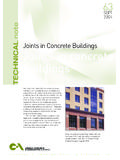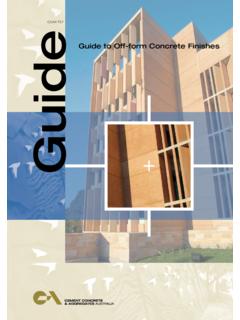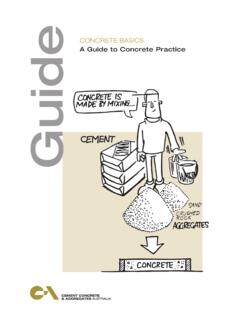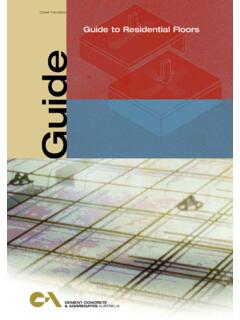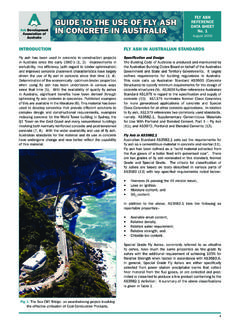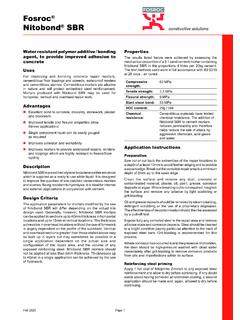Transcription of Durability of Masonry Mortar - CCAA
1 TechnicalnoteMAR 2007 INTRODUCTIONThe majority of Masonry structures exhibit excellent long-term performance with comparatively low maintenance cost. Durability of a Masonry structure is influenced by many factors including the Durability of both the Masonry units and Mortar , as well as proper installation of a damp proof course; the Durability of the Mortar contributes significantly to the overall Durability . Mortars used in Masonry structures exposed to aggressive environments are designed to resist a range of possible physical and chemical degradations. The physical forms of degradation may be caused by abrasion from wind action, salt crystallisation and freeze-thaw action; the chemical form of deterioration is usually caused by reactions with soluble salts.
2 In Australia, Masonry degradation is more likely to occur as a result of the physical effects of salt crystallisation or abrasion from wind assess the potential long-term performance of Masonry Mortar , a Durability test, based on a controlled scratching of the Mortar surface, has been successfully developed2. Durability of Masonry MortarDurability of Masonry mortar67 Hyde Park Barracks Sydney 1818 Page Durability of Masonry MortarThe penetration into the Mortar is measured and called the scratch index. It is noted that the test simulates and accelerates the physical forces that can cause Mortar degradation in service in typical Australian environments. A set of performance criteria has been developed from a comprehensive laboratory and field evaluation programme and included in the Australian Standard for Masonry Structures, AS STANDARDThe Durability performance requirement in AS 3700 is that a Masonry member or structure shall withstand the expected wear and deterioration throughout its intended life (taking into account the exposure environment and the importance of the structure) without the need for undue standard recommends the use of a range of classes of Mortar for different exposure conditions.
3 It also gives deemed-to-satisfy Mortar compositions for each class of Mortar . For other compositions, performance limits in terms of scratch indices are given for all classes of AFFECTING DURABILITYA major research program to investigate factors affecting the Durability of Masonry Mortar has recently been examines the influence of Masonry unit, Mortar ( cement type, sand and mix proportions) and joint finish on the potential Durability of three classes of Mortar in two exposure conditions. Durability is measured as scratch index taken after various periods of exposure from 7 days to three years. The factors investigated were: Mortar class: M2 (1:2:9), two M3 (1:0:5, 1:1:6) and M4 (1: :3) cement : Three commercial cements GP, GB1, GB2 Two laboratory blends GL1, GL2 Sands: Dune, Fatty bush and Coarse sandJoint finish: Ironed, Raked and Flush jointsMasonry unit: Dry-pressed and Extruded unitExposure.
4 Indoor and severe scratch test in progressTABLE 1 Deem-to-satisfy Mortar compositions and scratch index for each class of Mortar (extracts from Tables , and AS 3700) Deem-to-satisfy mix proportions (by volume) Mortar class Scratch IndexExample of exposure cement (GB/GP) Building lime Sand (mm)M Mild, interior 1 2 9 and drying, marine 1 1 6 1 0 5M4 Below dpc in aggressive soil, severe marine 1 1 0 4 1 0 3 Durability of Masonry Mortar Page 3 Typical cement :lime:sand Mortar compositions were chosen with one exception of an M3 mix of cement and sand without lime. A range of cements, complying with the Australian Standard AS 3972 Portland and blended cements, was investigated. The cements comprised three commercial cements: a GP and two GB, and two laboratory blends representing the upper bound of addition of fly ash (50% by mass) and slag (70% by mass).
5 Newcastle Beach dune sand is largely single-sized fine sand whereas the Bricklayer s White coarse and the fatty bush sand are well graded sands. The fatty bush sand has a large amount of very fine particles passing 150 m. The three sands represented commercially available sand used for Masonry PerformanceAll 360 Mortar joints performed well in terms of scratch indices and visual observation of deterioration. The average scratch indices were in the range of mm. This is well within the limits stipulated in AS 3700 for each class of Mortar , irrespective of the type of cement , sand, joint finish and Masonry results show that Mortar class, cement , sand, joint finish, Masonry unit and period of exposure are all statistically significant factors affecting the Durability of the Mortar joints.
6 The type of exposure, however, did not significantly affect the scratch index. In the severe marine exposure, measurement up to a period of three years exposure did not show any significantly greater deterioration than corresponding Mortar joints in the mild laboratory of the results was based on the trend in the mean values supported by statistical analysis. Average scratch indices reduced with length of exposure, indicating improved Durability . This was probably a consequence of ongoing hydration of cement in the Mortar . There was a consistent increase in the indices at the end of year 2, which was completely reversed at the end of year 3. This did not alter the pattern of relative effects from the various factors, as shown in the plots of two-way interactions (page 4) and discussed in the pier showing test locationsIndoor (laboratory exposure)7-day test >90-day test >365-day test > < 28-day test< 180-day test< 720-day testMarine exposurePage 4 Durability of Masonry MortarMarine Ironed Coarse Fatty Dune M4 (1 :3) GL2(FA blend) GL1(slag blend) GB2(FA blend) GB1(slag blend) GP M3b(1:0:5) M3a(1:1:6) M2(1:2:9) Raked Flush 1092 720 365 180 90 28 7 Laboratory Laboratory Marine Clay extruded Clay pressed Flush Raked Ironed Fatty Dune Coarse M2(1:2:9) M3a(1:1:6) M3b(1:0:5) M4 (1.)
7 3) GP GB1(slag blend) GL1(slag blend) GB2(FA blend) GL2(FA blend) 7 28 90 180 365 720 1095 Clay extruded Clay pressed MEAN SCRATCH INDEX (mm) MEAN SCRATCH INDEX (mm) SITE AGE (Days) UNIT JOINT Mortar cement SAND Two-way interactions for 7- to 1095 day data Factors are shown in the top row and diagonally from top left to bottom rightDurability of Masonry Mortar Page Effect of MortarClass of mortarThe higher class of Mortar provides better Durability than the lower classes in the following order M4 (1: :3), M3 (1:1:6) and M2 (1:2:9). The higher cement content in the higher class resulted in lower scratch index. This confirms previous findings1 of the relationship between penetration index and cement content.
8 The M3 (1:0:5) mix, which contains no lime, is an exception, showing higher scratch index despite higher cement content and lower water- cement ratio. This was particularly the case with the dune sand and was partially caused by the absence of lime, which improves water retention and promotes continued hydration of cements. Another reason is that the other sands, even in a 1:0:5 mix, contain sufficient fines to produce a denser surface with a lower scratch Mix cement and Lime Contents cement content Lime content Mortar mix (Vol %) (Vol %)1:2:9 :1:6 :0:5 :3 of the class of Mortar , all mortars investigated had scratch indices well below the AS 3700 limits. Thus the use of AS 3700 deemed-to-satisfy Mortar compositions has been shown to provide durable Mortar for Masonry of cementAll five cements, three commercial cements and two laboratory blends, result in Mortar with low scratch indices.
9 The three commercial cements show better performance than the two laboratory blends which yield high initial indices but require 90 180 days before developing similar scratch resistance to the commercial cements. Thus all standard-complying cements are suitable for durable Masonry of sand The dune, fatty bush and coarse sand represented the spectrum of sands used for Masonry construction. All three sands resulted in durable mortars as indicated by the scratch indices. The use of coarse sand resulted in the best scratch resistance, followed by the fatty and dune sand respectively. This is so despite the relatively higher water- cement ratio found in mortars with the coarse and fatty sand compared with corresponding Mortar with dune of FinishesRaked and ironed finishes were found to give better scratch index than the flush finish.
10 This is due to the tooling action which compacts the Mortar as well as bringing the cement to the surface of the raked and ironed joints. Ironed finish gave the lowest scratch index with all combinations of sand and mix sand Fatty sand Coarse sandThree sands used in the study05101520 cement CONTENT BY VOLUME (%)PENETRATION RATE (mm per turn) between penetration index and cement contentRaked finish Ironed finish Flush finishThree finishes used in the studyPage Durability of Masonry MortarEffect of Masonry UnitPressed units show a lower scratch index than the extruded units, possibly due to the different water absorption characteristics and surface texture. The pressed units have a mean initial rate of absorption (IRA) of compared to found in extruded units.


